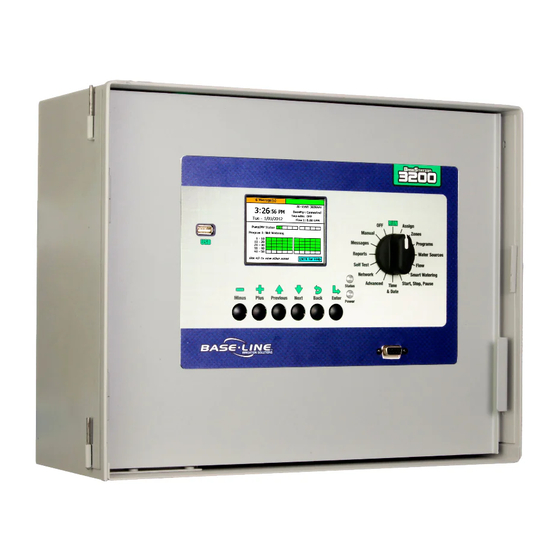
Baseline BaseStation 3200 Manual
Irrigation controller upper threshold moisture sensor-based watering
Hide thumbs
Also See for BaseStation 3200:
- Quick start manuals (16 pages) ,
- Setting up (8 pages) ,
- Manual (5 pages)
Table of Contents
Advertisement
Quick Links
BaseStation 3200 Irrigation Controller
Upper Threshold
Moisture Sensor-Based Watering
If you have a Baseline soil moisture sensor (biSensor™) installed in your landscaping and connected to
your BaseStation 3200 irrigation controller, you can program the controller to water based on the
moisture levels in the soil. This watering strategy can reduce outdoor water use by up to 62 percent or
more over traditional irrigation methods. And, by watering your plants when needed, you can increase
landscape health, promote deeper root growth, and make your plants more disease resistant.
For areas that have a restricted schedule such as specific watering days or specific use schedules like
sports fields, upper threshold (also referred to as "greater than limit" or "upper limit") is a popular
watering strategy. With upper threshold, you can choose which day and what time of day to start
watering and the sensor will shut off watering when soil moisture reaches the upper threshold, which is
usually slightly above field capacity.
The upper threshold watering strategy varies the zone water time each time the program runs in order
to apply enough water to raise the moisture level to field capacity. Soak cycles are critical for this mode
because the controller monitors the moisture level as water is applied. At the end of each soak cycle,
the controller determines whether an additional water cycle is needed. After the upper limit has been
reached, the controller will water for an additional 10% of the water time to increase deep watering.
Note: Make sure your program's runtime is sufficient to raise the moisture content in the soil to field
capacity. You should put down at least ½ - ¾ inch of water each time the controller is allowed to water.
Overview of Soil Moisture Levels
The amount of moisture held in the soil varies depending on the type of soil and the amount of time
between watering events. When you're using a sensor-based watering methodology, you should have a
general understanding of the water holding capacity of various types of soil. We've included a brief
description of the standard soil moisture content levels in this document. You can learn more about soil
moisture content, soil classification, infiltration, and water movement in Baseline's document titled
Watering with Soil Moisture
Sensors.
Soil moisture content is identified by the following levels:
Saturation: At the saturation level, nearly all of the spaces between soil particles are filled with water.
As a rule, irrigators do not want to saturate the soil because it cuts off the plant's supply of oxygen,
which, in effect, drowns the plant.
Field Capacity: When soil is at the field capacity level, it means that all excess moisture has drained
freely from that soil. The amount of remaining moisture is the field capacity. To irrigate properly, you
would turn off the water when the soil in the root zone of the plants reaches field capacity. A Baseline
biSensor measures field capacity in the calibration process and uses this value as the basis for other
settings.
Baseline Support: 866-294-5847
1
www.baselinesystems.com
Advertisement
Table of Contents

Summary of Contents for Baseline BaseStation 3200
- Page 1 The amount of remaining moisture is the field capacity. To irrigate properly, you would turn off the water when the soil in the root zone of the plants reaches field capacity. A Baseline biSensor measures field capacity in the calibration process and uses this value as the basis for other settings.
- Page 2 Make sure that you maintain polarity on the wire connections. Fasten the wiring with wire nuts, and then test communication with the controller before you complete the installation with waterproof connectors. Baseline Support: 866-294-5847 www.baselinesystems.com...
- Page 3 For example, a primary zone has 20 linked zones. If you change the mode of the primary zone to linked or timed, the links to the 20 zones will be broken. Baseline Support: 866-294-5847 www.baselinesystems.com...
- Page 4 + or – button to enter it in this field. You can also perform a Learn Flow operation to update this field. Refer to Learning Flow by Zone in the BaseStation 3200 User Manual. 5. Press the Next button to move to the Enabled field. Press the + or – button to toggle the value in the field between YES and NO.
- Page 5 5. Press the Enter button. The system lists the serial numbers of all biSensors that it finds. Note: The BaseStation 3200 supports 25 biSensors. 6. Press the + or – button to highlight the serial number of the biSensor that you want to assign, and then press the Enter button. The serial number moves from the list on the left to zone address on the right.
- Page 6 If you think that you might need to use this field, contact Baseline Support for help. 7. Press the Next button to move to the Calibration Cycle field.
- Page 7 Note: If you want information about the schedule types that are available, refer to Setting Up the Start Days for a Program in the BaseStation 3200 User Manual or view the online help on the Start Days screen on the controller.
- Page 8 (like a mow day). Pressing the Enter button will maintain the current selected field and advance through the days of the week. Step 9 – Setting the Controller to Run When you have finished making changes, turn the dial to the RUN position. Baseline Support: 866-294-5847 www.baselinesystems.com...

Need help?
Do you have a question about the BaseStation 3200 and is the answer not in the manual?
Questions and answers
how many amps are required to power up and run a basestation 3200